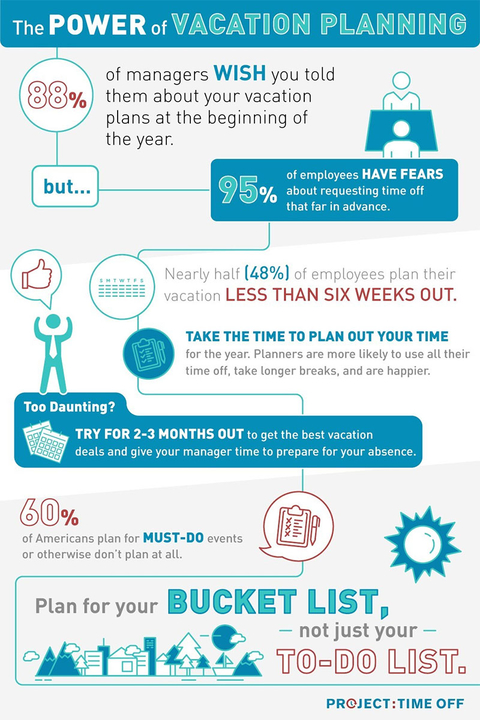Fewer than half of Americans (49%) take the time to plan their vacation days out each year, according to new research from Project: Time Off, held back by lack of certainty with personal schedules (64%), work schedules (57%), and children's schedules (50%). The new findings were released in anticipation of National Plan for Vacation Day on January 30.
The findings, from The Power of Vacation Planning report, offer an in-depth look at why Americans' planning behavior based on GfK survey research of 2,076 U.S. employees who earn paid time off for National Plan for Vacation Day. The national observance is dedicated to encouraging Americans to plan their vacation days for the rest of the year at the start of the year. By failing to block the calendar, Americans are creating a stockpile of 662 million unused vacation days and a $236 billion missed opportunity for the U.S. economy.

"At the beginning of the year the calendar is still full of possibility and there is no better time to start planning vacation days," said Katie Denis, chief of research and strategy at Project: Time Off in a written statement. "Americans who want to use more of their vacation time can put themselves in a better position to do so by planning ahead—and their request is more likely to be approved by the boss."
The lack of planning has implications in the office. Managers are near universal (91%) in saying they want to approve vacation requests, but a significant 43 percent say they are sometimes unable to because their employees did not provide enough notice. Nearly half (48%) of employees give six weeks or less notice when taking at least a week off; just 19 percent give three months or more.
Employees may be intimidated to give more notice. About a quarter of employees fear that their boss would not approve of them asking about all their plans for the year up front (27%). But an overwhelming majority of managers say it would be helpful to know their direct reports' vacation plans for the year at the start of their company's fiscal year (78%) and think that employees who share their plans that far in advance are being responsible (88%).
Better advanced planning could help alleviate the mountain of work employees fear returning to. As it stands today, the majority (57%) of employees are leaving all or more of their work for when they return or taking it with them on vacation.
"No one wants to spend their precious time away with work stress hanging over their head," added Denis. "The more time you have to prepare before you leave, the more enjoyable the vacation experience—it's no wonder that planners are happier people."
Planners have a distinct advantage over non-planners. According to Project: Time Off's The State of American Vacation 2017, workers who set aside time each year to plan out their vacation days use more of their vacation time, take longer breaks, and report greater happiness than non-planners with their relationships, health and well-being, company, and job.
To help Americans plan, Project: Time Off launched a vacation planning tool that lets employees enter in the number of days off they earn, plot out how they want to spend them, save to their calendars, and export to their friends and family—and even their bosses. Travel organizations are also offering discounts, giveaways and sweepstakes, and itineraries for vacations.
"It's time for Americans to reclaim their calendar and vacation time," said Cait DeBaun, director of communications for Project: Time Off. "Make 2018 the year you check an item off your travel bucket list…not just your to-do list."
National Plan for Vacation Day, celebrated on the last Tuesday of January, is a day to encourage Americans to plan their vacation days for the rest of the year at the start of the year. Launched by the U.S. Travel Association's Project: Time Off initiative in 2017, National Plan for Vacation Day provides an opportunity to come together at a single moment to rally around the importance of planning for vacation. In its inaugural year, more than 600 organizations, representing all 50 states came together to encourage Americans to plan for vacation.
Source: ProjectTimeOff.com/Plan
Related Stories
Stats: Hawaii’s Average Daily Hotel Rate Rose to $319 in December
Stats: U.S. Falls to #3 Travel Spot; Spain at #2
Stats: 52% of Millennials Prefer Hotels, Not Airbnb
Stats: New York, Indonesia Top Most-Instagrammed Honeymoon Spots